1930s Fashion Key Trends
1930s Fashion key trends witnessed significant transformations that reshaped how clothing was designed and worn. From innovative cutting techniques to the rise of practical garments, this period marked a shift towards both elegance and functionality. These changes influenced high fashion and made stylish attire more accessible to a broader audience.
The Bias Cut Revolution
In the 1930s, fashion took a transformative turn with the advent of the bias cut, a technique that changed how clothing fit and moved with the body. Pioneered by French couturier Madeleine Vionnet, the bias cut involves cutting fabric at a 45-degree angle to its weave, allowing it to drape and stretch naturally. This innovative technique resulted in garments that adhered to the body’s curves, offering a fluid and feminine silhouette that was both elegant and comfortable.
Vionnet’s bias-cut dresses stood apart from the stiff, structured garments of previous eras. Evening dresses in luxurious silks and satins, often with low backs and slinky lines, became synonymous with Hollywood glamour. Stars like Jean Harlow and Claudette Colbert flaunted these figure-hugging gowns, cementing their place in fashion history. The practical beauty of the bias cut extended beyond the red carpet, as it was adopted widely in daywear too.
The bias cut didn’t just cater to high society; it democratized fashion. This technique made it possible for garments to fit a variety of body shapes without extensive alterations. Renowned fashion houses like Chanel, Schiaparelli, and Lanvin incorporated it into their collections. Day dresses featured softer lines, intricate patterns, and feminine details like flared skirts and defined waistlines.
The bias cut method brought with it a slew of benefits:
- Enhanced the wearer’s silhouette
- Offered a snug yet flexible fit
- Allowed for greater movement and comfort
Women’s work suits embraced the elegance of the bias cut, balancing functionality with refined elegance. More women were entering the workforce, and their attire had to reflect both their professional roles and fashion sensibilities.
In all its uses, the bias cut was a game changer, pushing the boundaries of what fashion could achieve. It seamlessly blended visual appeal with practicality, a hallmark of Vionnet’s genius. A simple bias-cut dress could transform the everyday into something truly special, blending comfort, movement, and impeccable style.
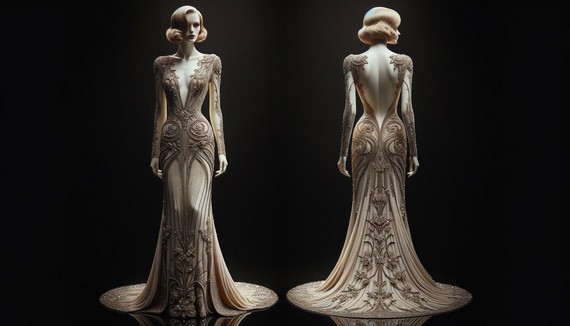
An elegant 1930s bias-cut evening gown in satin, showcasing its fluid lines and body-hugging silhouette
1930s Fashion Key Trends – Backless Silhouettes
The backless silhouette emerged as a hallmark of 1930s glamour, redefining elegance and sensuality. With hemlines returning to floor length, designers sought new ways to introduce allure into eveningwear, and showcasing the back became their chosen avenue.
Dresses featuring plunging backlines replaced the previously favoured shorter hemlines, creating a new focal point of sophistication. Iconic stars like Jean Harlow and Greta Garbo dazzled on and off the screen in these designs, turning heads and setting trends. The bare-back look became emblematic of a modern, confident woman.
Designers like Vionnet, Chanel, and Schiaparelli embraced the challenge of creating garments that were as structurally intricate as they were visually stunning. The backless gown demanded skillful design and required innovations in undergarments to maintain that seamless, elegant look. Pliable girdles and backless bras were designed to offer support without being visible beneath these daring dresses.
To ensure the gowns stayed perfectly in place, hidden straps and clever cutouts became part of the craftsmanship. The back was adorned and accentuated with:
- Sequins
- Delicate lace
- Intricate embroidery
This provided an excellent opportunity for artisans to showcase their craftsmanship, creating dresses that were as detailed and ornate at the back as they were at the front.
Photographs from the period, like those of Lee Miller in her timeless Vionnet gowns, capture the essence of this trend. They reveal how the backless dress was not just about showing skin, but about integrating a sense of movement and fluidity into the garment.
The popularity of the backless dress can also be attributed to Hollywood’s golden age. Films provided the perfect medium to showcase these daring designs to a wider audience. When stars graced red carpets or appeared in promotional stills in backless dresses, they inspired countless women to embrace this bold look.
Ultimately, the backless silhouette reflected a shift in societal norms and attitudes toward female beauty and empowerment. The careful design and supportive innovations required for these gowns demonstrated the collaboration between fashion and functionality. The legacy of the backless dress endures today, paying homage to an era where fashion took bold strides forward, liberating women to explore new areas of elegance and self-expression.
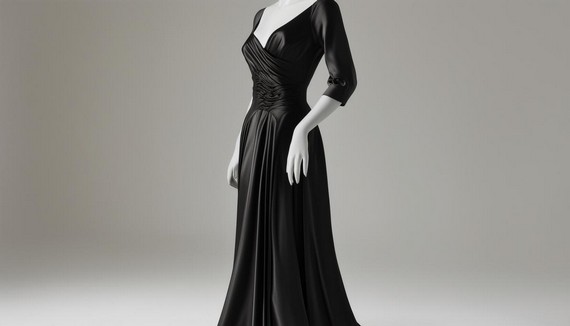
A glamorous 1930s backless evening gown with intricate embroidery and sequins adorning the open back
The Rise of Women’s Trousers
The 1930s witnessed the subtle but steady rise of trousers for women. Once relegated to the male wardrobe, trousers began to carve a niche for themselves in women’s fashion, primarily through sports and leisure activities. The integration of trousers into women’s daily wear marked a progressive shift towards a more practical and liberating fashion approach.
Initially, trousers made their entry point through sportswear. As outdoor sports and physical activities gained popularity, women sought clothing that afforded them the mobility and comfort required for pursuits such as golf, tennis, and hiking. The loosening cultural attitudes towards women’s dress codes allowed trousers to make inroads, first in private spheres before gradually appearing in public settings.
Elsa Schiaparelli, the avant-garde fashion designer known for her surrealist influences, was among the bold pioneers who championed trousers for women. She brought trousers into high fashion, creating collections that featured daring and stylish trousers alongside her iconic haute couture pieces. Her 1931 collection showcased a striking blend of sophistication and practicality.
Maggy Rouff, another key figure in this sartorial evolution, crafted trousers that balanced comfort with chicness. Rouff’s designs were celebrated for their elegance and were often featured in prominent fashion magazines, subtly advocating for the acceptance of trousers in women’s wardrobes.
While designers like Schiaparelli and Rouff pushed the fashion envelope, creating new key trends in 1930s fashion, the debate surrounding the cultural acceptance of women wearing trousers was rife. Articles in magazines like Vogue discussed the appropriate contexts and settings for women to don trousers, often relegating them to sport, leisure, or home activities rather than the office or social gatherings.
One notable milestone in the gradual acceptance of women’s trousers was Vogue’s 1936 article, “What About Pants? Where? When?” The deliberative tone of the piece encapsulated the hesitant yet inevitable integration of trousers into everyday 1930s fashion. By addressing the circumstances in which trousers might be deemed appropriate, the article inadvertently promoted the idea that trousers were indeed a viable option for women.
This period also witnessed trousers becoming a symbol of empowerment and independence for women. The rising trend of wide-leg trousers, inspired by sailor uniforms and leisure wear, epitomised this shift. Designed for ease and elegance, they allowed women to move freely while maintaining a sense of style and grace.
In essence, the gradual acceptance of women’s trousers in the 1930s was indicative of broader societal transformations. The push from influential designers, coupled with evolving cultural attitudes towards women’s roles, facilitated the slow but steady transition of trousers into mainstream fashion. This movement laid the groundwork for future generations, where trousers would become a staple in every woman’s wardrobe, reflecting a harmonious blend of practicality, style, and liberation.
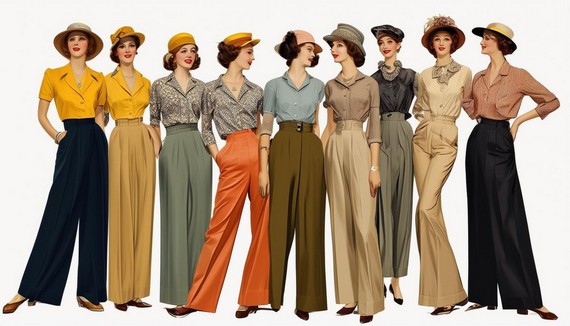
A group of fashionable women in the 1930s wearing a variety of stylish wide-leg trousers for different occasions
1930s Fashion Key Trends – Hollywood’s Influence on Fashion
Hollywood’s impact on 1930s fashion was significant. The glamour of the silver screen inspired people to emulate their favorite stars’ styles. Costume designers like Gilbert Adrian played crucial roles, establishing trends through their innovative designs for film.
Adrian, the creative force behind iconic looks in many MGM films, was instrumental in this movement. His designs for stars like Joan Crawford and Greta Garbo extended beyond cinema, embedding themselves into everyday fashion. Crawford’s white organdie gown from Letty Lynton (1932) is a prime example. With its nipped-in waist, full skirt, and voluminous puffed sleeves, the gown became a fashion sensation across the United States. Macy’s alone sold thousands of copies, illustrating Hollywood’s impact on consumer behavior.
Joan Crawford’s style choices, on and off screen, were widely emulated. Her continued partnership with Adrian resulted in more trailblazing styles, from slinky, bias-cut gowns to suits that accentuated her powerful silhouette. Each look set new standards and trends, proving film’s potency as a medium for fashion innovation.
Greta Garbo, with her enigmatic presence and androgynous allure, also became a fashion trailblazer. Her preference for clean, minimalist lines and strong silhouettes contrasted with the ornate styles of previous decades. Garbo’s on-screen wardrobe featured sleek gowns and sharp suits exuding sophisticated elegance. Off-screen, her preference for trousers and menswear-inspired looks further influenced everyday fashion, encouraging women to embrace practical and versatile attire as key trends in 1930s fashion, without sacrificing style.
Costume design involved intricate storytelling, with each garment helping to define a character. When filmgoers saw their favorite stars in these exquisite designs, they longed to emulate those styles, believing they could capture some of the stars’ allure and sophistication.
Hollywood’s reach extended beyond the film theater. Fashion magazines frequently featured film stars, blurring the lines between cinema and fashion. These publications provided tips on recreating the glamorous looks of stars, making high fashion more accessible to everyday women. The advent of ready-to-wear collections meant these styles became more affordable and attainable.
The influence of Hollywood on 1930s fashion underscores the interplay between media and society. Cinema became a powerful vehicle for fashion trends, pushing boundaries and setting new standards for style and elegance. These trends defined an era, inspiring subsequent generations and solidifying the bond between fashion and film that continues today.
A collection of 1930s Hollywood fashion icons wearing glamorous gowns and suits that influenced everyday fashion
1930s Fashion Key Trends – Technological Advances in Fashion
The 1930s saw remarkable technological advances that made fashion more accessible and practical. Innovations like rayon, nylon, and zippers enabled even those in financial hardship to partake in sartorial trends.
Rayon: The “Artificial Silk”
Rayon, often called “artificial silk,” emerged as a game-changing key trend in 1930s fashion. This cheaper alternative to natural silk offered a luxurious drape and feel, appearing in everything from day dresses to elegant evening gowns. Vogue praised rayon’s versatility and practicality, showcasing its potential to create stylish garments that mirrored the opulence of true silk. By reducing production costs, rayon allowed women from various backgrounds to wear chic and contemporary attire.
Nylon: Revolutionizing Hosiery
Nylon revolutionized the hosiery and undergarment industries. It provided an elegant yet durable alternative to silk stockings, offering women a longer-lasting product that maintained its aesthetic appeal. Nylon showcased how fashion could adapt and thrive amidst economic constraints, proving that innovation could result in practical yet stylish solutions.
Zippers: Simplifying Garment Construction
Zippers played a crucial role in simplifying garment construction and enhancing wearability and was a key trend in 1930s Fashion. Before their widespread adoption, garments were often fastened with buttons, hooks, or laces, making them time-consuming to produce and somewhat cumbersome to wear. Designers like Elsa Schiaparelli embraced the zipper, incorporating it into high fashion in ways that were both functional and decorative. The use of zippers streamlined clothing production, reducing costs and making stylish pieces more accessible to the broader public.
1930s Fashion Key Trends – Impact on Fashion Inclusivity
These technological breakthroughs marked a shift towards inclusivity and practicality in fashion. During a time when economic distress could have stifled creativity, the fashion industry instead responded with ingenuity and resilience. The introduction of cheaper, man-made fabrics and efficient fastenings meant that elegant, well-made clothing was within reach for many who had previously been excluded from high fashion.
These advancements laid the groundwork for future key trends in 1930s fashion and developments. The use of rayon and nylon set the stage for the proliferation of synthetic textiles in the following decades, further revolutionizing the fashion industry. Zippers became a standard fastening, integral to the construction of everything from casual wear to haute couture.
The intersection of technological advancements and economic necessity during the 1930s played a pivotal role in democratizing fashion. Elements such as rayon, nylon, and zippers bridged the gap between luxury and accessibility, allowing a broader audience to engage with contemporary styles. These innovations reflected the key trends in 1930s fashion and a broader cultural shift toward inclusivity, practicality, and resilience, shaping the future of fashion.
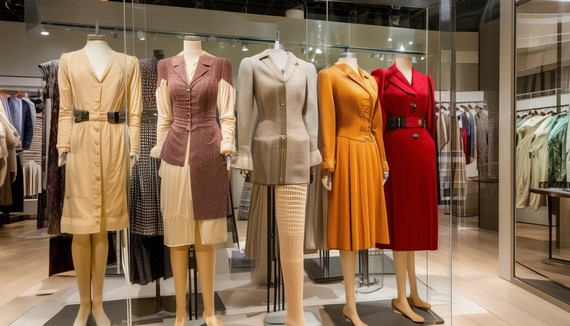
A display showcasing fashion technology innovations including rayon fabrics, nylon stockings, and zipper fastenings
The 1930s were a pivotal time for the key trends that emerged in 1930s fashion and witnessed significant transformations that reshaped how clothing was designed and worn., blending practicality with style in ways that continue to influence modern wardrobes. Whether through the bias cut, backless silhouettes, or the rise of women’s trousers, this era set the stage for future innovations, making fashion both a form of expression and a reflection of societal shifts.
1930s Fashion Key Trends – 1930s Fashion Silhouettes and Cuts
The 1930s marked a significant shift in fashion, moving away from the carefree styles of the 1920s to embrace more structured and elegant designs. This period saw the return of natural waistlines, innovative cutting techniques, and a blend of practicality with sophistication.
Natural Waistlines and Feminine Silhouettes
The 1930s saw a dramatic shift from the loose, boyish shapes of the 1920s to sleek, feminine styles. Waistlines returned to their natural position, emphasized by belts and waistband detailing. This change gave rise to a more sophisticated look.
Frocks and gowns now boasted seams just below the bust, highlighting curves rather than hiding them. The structured bodices were a departure from the carefree flapper dresses of the previous decade.
Madeleine Vionnet introduced the bias cut, a technique of cutting fabric at a 45-degree angle against the weave. This allowed garments to drape and hug the body, emphasizing natural curves and transforming dresses into fluid, graceful pieces.
Broad shoulders also defined the decade. Shoulder pads, puffed sleeves, and capelets added volume and structure. Think of Joan Crawford in her iconic films, with broad shoulders framing her svelte figure.
Hemlines fell between mid-calf and ankle length, whether straight, A-line, or flared. Pleats or gores provided movement, keeping things practical without losing style.
Eveningwear was luxurious, with floor-length gowns in silk or satin. Open backs, halter necklines, and intricate beading made these dresses showstoppers.
Daywear remained practical but stylish. Dresses with buttoned fronts, collars, and cuffs became popular. Gored skirts and princess seams hugged the body closely while flaring out at the hem. Ruching and shirring added texture and interest.
Working women’s fashion combined function and elegance. Silk or rayon chiffon blouses with ornamental ties and frills paired with fitted skirts, often featuring added fullness at the hem through pleats or flared gores.
Sports and outdoor activities influenced fashion, leading to the emergence of wide-leg trousers and lounge pants. Sailor and military styles also made their mark.
To recreate the 1930s look, consider:
- Silk or chiffon blouse
- Calf-length skirt with an inverted front pleat or slight flare
- Bias-cut tea dress with puff sleeves
- Wide-leg trousers
- Bias-cut floor-length gown in silk satin or rayon
- A silk or rayon slip
Essential accessories:
- Tilt hat or beret
- Faux or real vintage fur
- Patterned silk scarf
- Gloves
- Statement jewelry
1930s prints often featured Art Deco styles, with cubism-influenced patterns and contrasting colors. Daywear favored earthy tones, while eveningwear often saw whites, champagnes, and blacks.
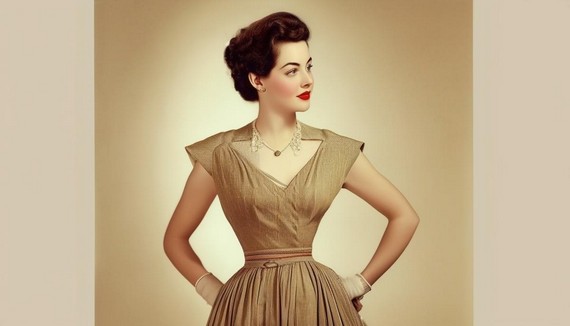
A woman wearing a 1930s dress with a natural waistline, fitted bodice, and slightly flared skirt, emphasizing the feminine silhouette of the era
1930s Fashion Key Trends – The Bias Cut Revolution
Madeleine Vionnet’s introduction of the bias cut transformed 1930s fashion. This technique of cutting fabric at a 45-degree angle against the weave allowed for garments that draped softly over the body, skimming every natural curve without the need for stiff structures or excessive seams.
Evening dresses in silks and satins became masterpieces of design. They hugged the body in all the right places, creating a slinky silhouette that was both sensual and sophisticated. These gowns often featured low backs or halter necklines, turning simple entrances into memorable moments.
Daywear also benefited from the bias cut. Day dresses maintained elegance while incorporating practical features. Intricate pattern cutting techniques resulted in irregular hems, layered panels, and tiers, often in light, floaty fabrics like printed chiffon.
Art Deco-inspired prints added another layer of allure. Whether geometric patterns, playful dots, or abstract designs, the bias-cut transformed simple dresses into works of art that married form and function. Daywear became less about utility and more about expressing personality and style.
Even for working women, the bias cut found its place. Silk and rayon blouses benefited from the fluid fall of the fabrics, making functional garments appear elegant and refined. Paired with fitted skirts, these outfits retained sophistication without appearing frumpy.
The bias cut balanced simplicity with sophistication, making every piece versatile, wearable, and chic. Whether dressed up or down, garments cut on the bias flattered in ways traditional methods couldn’t match, ensuring their timeless appeal in today’s vintage-inspired fashion.
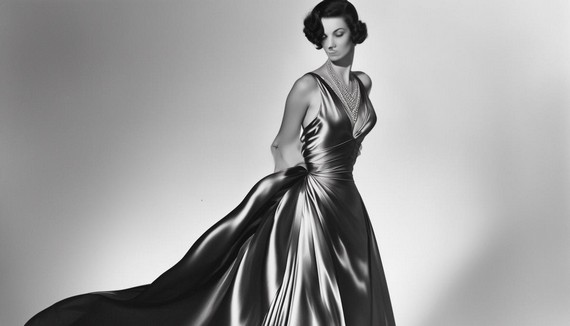
A model wearing a stunning bias-cut evening gown in satin, showcasing the fluid drape and body-skimming silhouette typical of 1930s fashion
Broad Shoulders and Fitted Bodices
Broad shoulders and fitted bodices defined the distinctive 1930s silhouette, blending strength and elegance. Shoulder pads became fashionable, adding volume and creating a powerful shape that was both elegant and commanding. This style exuded confidence while maintaining femininity, reflecting the evolving role of women during the era.
Puffed sleeves and capelets accentuated the shoulder line, transforming simple dresses into statement pieces. These elements provided the structural framework that elevated every outfit, giving it that unmistakable 1930s edge.
Fitted bodices highlighted the natural curves of the body. Women looked effortlessly chic in dresses that skimmed the torso closely before flaring out gently at the hips or hem. The construction employed darts and seams to contour the body perfectly, ensuring that the fabric laid smoothly against the skin.
Hollywood stars like Joan Crawford epitomized this trend. Her broad-shouldered outfits weren’t merely costumes; they were style icons, influencing women worldwide. Whether in a glamorous evening gown or a chic daytime ensemble, her look spoke volumes about the fashion ethos of the time—strong, elegant, and glamorous.
Daywear also benefited from this structured approach. Dresses with buttoned fronts and dainty collars were elevated by fitted bodices and broad shoulders. These weren’t just practical garments; they were the epitome of everyday elegance.
The construction of fitted bodices allowed for a subtle play of textures and fabrics. Ruching, shirring, and carefully placed pleats or tucks provided visual interest and added depth to the garments. These details were executed with an effortless grace that made every piece undeniably chic.
The combination of broad shoulders and fitted bodices encapsulates what 1930s fashion was all about: a seamless blend of strength and sophistication. The era’s clothing projected an image of elegance grounded in structured design and precise craftsmanship, a style that continues to inspire and influence contemporary fashion.
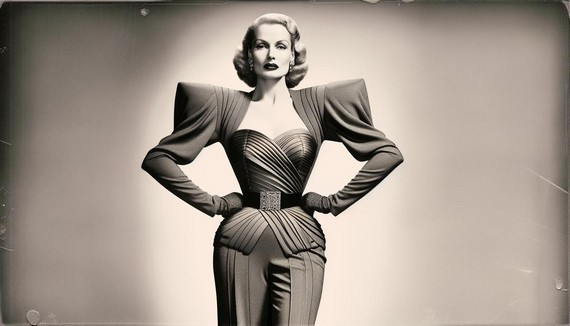
Joan Crawford in a 1930s outfit featuring exaggerated broad shoulders and a fitted bodice, exemplifying the iconic silhouette of the era
Elegant Eveningwear and Practical Daywear
The 1930s fashion scene presented a captivating contrast between elegant eveningwear and practical yet stylish daywear. This period merged luxury with everyday functionality, catering to both glamorous events and daily life.
Eveningwear of the 1930s was captivating. Floor-length gowns crafted from fine silks and satins cascaded gracefully over the body. These dresses often featured plunging backs, halterneck straps, and lavish beadwork, creating an aura of sophistication. The bias cut allowed fabrics to cling and drape sensuously, accentuating natural contours. Designers like Elsa Schiaparelli and Madeleine Vionnet turned these dresses into icons of the age, often embellished with art deco motifs or sparkling sequins.
In contrast, daywear prioritized practicality without sacrificing style. Fabrics shifted from luxurious silks to more durable materials like rayon and cotton. Designs became functional, adapting to the needs of working women and daily life, yet retained the decade’s characteristic flair for detail and refinement.
Day dresses typically featured structured bodices and modest necklines, with hemlines falling between mid-calf and ankle length. Patterns such as florals, plaids, and dots lent a playful yet polished aesthetic, often complemented by carefully selected accessories. A dress might include a buttoned front for practicality, with collars and cuffs lending an air of modest sophistication.
The construction of daywear did not hinder movement or comfort. Gored skirts offered fluidity and ease, while pleats and flares added elegance. Blouses made from silk or rayon chiffon, adorned with ornamental ties and frills, were paired with skirts that skimmed the hips before flaring out at the hem—creating a silhouette both refined and functional.
Wide-leg trousers and suits also found favor, particularly for working women. These garments allowed for greater movement and ease while retaining a stylish edge.
Both evening and daywear during the 1930s shared a foundation of impeccable craftsmanship and thoughtful design, reflecting the era’s unique blend of necessity and elegance. The bias cut, intricate detailing, and quality fabrics underscored each piece, whether for a glamorous evening or a day about town.
1930s fashion celebrated versatility and class, proving that elegance could pervade every aspect of one’s wardrobe. Its ability to transition seamlessly from opulent to practical made it an enduring influence in style.
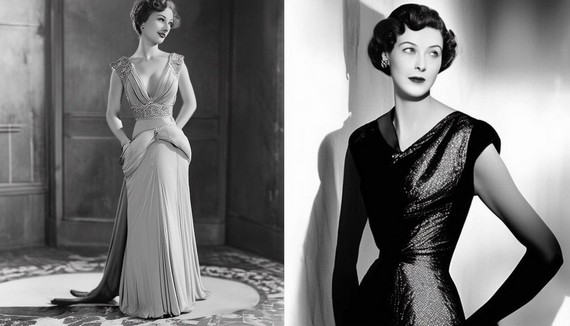
A split image showing a woman in an elegant floor-length evening gown on one side, and another in practical yet stylish daywear on the other, illustrating the contrast in 1930s fashion
1930s Fashion Key Trends – Influence of Hollywood and Designers
Hollywood stars significantly shaped 1930s fashion, with icons like Joan Crawford, Greta Garbo, and Marlene Dietrich setting trends that women worldwide wanted to emulate. Crawford’s broad-shouldered looks, particularly her white organdie gown in “Letty Lynton” designed by MGM’s Gilbert Adrian, sparked a fashion frenzy. This highlighted how fashion was becoming more accessible to the masses, even during the Great Depression.
Elsa Schiaparelli was another major influence, infusing surrealism into her designs through collaborations with artists like Salvador Dalí. Her work showcased:
- Bold colors
- Whimsical embellishments
- Innovative cuts
These elements epitomized the decade’s evolving silhouette with strong shoulders and cinched waists.
Madeleine Vionnet played a key role in defining 1930s fashion by popularizing the bias cut. Her designs allowed fabrics to drape and cling to the body flatteringly, giving evening gowns a new level of sophistication and allure.
Hollywood’s reach extended to menswear as well. Stars like Clark Gable and Fred Astaire became style icons, influencing consumer habits. Men’s fashion began to embrace a more relaxed, approachable style with:
- Knitted sweaters
- Soft-collared shirts
- Blazers worn with flannel trousers
Children’s fashion was also affected by Hollywood’s allure, with Shirley Temple’s frilly dresses and iconic ringlets becoming a style inspiration for little girls. Cinema democratized fashion, allowing even young fashionistas to emulate their on-screen idols.
Other designers like Coco Chanel continued to influence women’s wardrobes with practical yet chic designs, providing a softer, more relaxed counterpart to the structured styles of the era. Her use of simple lines and functional details solidified her status as a pioneer in women’s fashion.
The collaboration between designers and Hollywood stars shaped the trends and silhouettes of the decade. Cinema brought high fashion into ordinary people’s homes, making it both aspirational and attainable. The fashion of the 1930s wasn’t just about clothing; it reflected contemporary socio-economic factors and the glamour offered by Hollywood’s golden age.
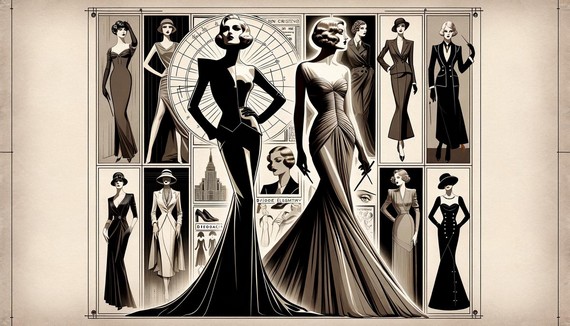
A collage showcasing Hollywood stars like Joan Crawford and Marlene Dietrich alongside designer creations by Elsa Schiaparelli and Madeleine Vionnet, illustrating their influence on 1930s fashion
The 1930s fashion blended elegance and practicality. From the bias cut revolution to the influence of Hollywood stars, every element contributed to a style that remains inspiring today. This period wasn’t just about clothing; it was about making a statement, reflecting strength, sophistication, and an enduring sense of grace.
1930s Fashion Key Trends – 1930s Fabrics and Textures
The 1930s blended practicality and elegance in fashion, with fabrics playing a crucial role. From silk’s luxury to wool’s warmth, each material had its place in women’s wardrobes for daily life and special occasions.
Key Fabrics of the 1930s
Silk set the stage for evening elegance, used for gowns and lingerie. Its smooth texture and gentle sheen were unmatched, often adorned with delicate embellishments like beads and sequins.
Cotton was the everyday hero, ideal for day dresses and casual wear. Valued for its comfort and practicality, cotton’s breathability kept women cool during summer. Lightweight cottons like broadcloth, percale, and lawn were favorites.
Wool offered warmth and durability for suits, coats, and winter garments. Worsted wool was common for dresses and suits, while flannel added a cozy touch to winter wardrobes. Tweed brought texture and richness to outerwear.
Rayon, marketed as artificial silk, was affordable and versatile. It offered a similar drape to silk and was used in dresses, blouses, and lingerie, making high fashion more accessible.
Velvet carried a rich, plush allure, commonly used for evening wear. It added depth and elegance to gowns and jackets, often in colors like royal blue, hunter green, and deep red.
Crepe, with its distinctive crinkled texture, became a favorite for both daywear and evening wear. It draped beautifully and came in various textures from smooth to lightly pebbled.
Chiffon, lightweight and sheer, added an ethereal quality to garments. Often used in evening gowns and blouses, it created a feminine and airy look.
| Fabrics | Characteristics | Uses |
|---|---|---|
| Silk | Smooth, luxurious, delicate sheen | Gowns, lingerie |
| Cotton | Breathable, comfortable, lightweight | Day dresses, casual wear |
| Wool | Warm, durable, sturdy | Suits, coats, winter garments |
| Rayon | Affordable, versatile, similar to silk | Dresses, blouses, lingerie |
| Velvet | Rich, plush, soft | Evening wear, gowns, jackets |
| Crepe | Crinkled texture, versatile, drapes well | Daywear, evening wear |
| Chiffon | Lightweight, sheer, delicate | Evening gowns, blouses |
Each fabric added its own flair to 1930s fashion, ensuring that practicality and elegance went hand in hand.
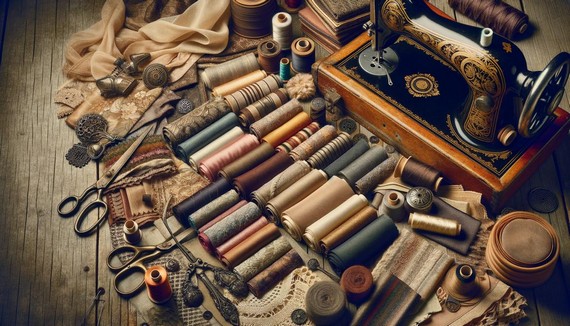
A collection of fabric swatches from the 1930s, including silk, cotton, wool, rayon, velvet, crepe, and chiffon, arranged on a vintage dressmaker’s table
Influence of the Great Depression on Fabric Choices
The Great Depression significantly impacted fabric choices in the 1930s. Economic constraints meant that fashion focused more on practicality and affordability. Women turned to more affordable materials like rayon and cotton. Rayon provided a luxurious feel without the high cost, while cotton became a staple for everyday wear.
Home sewing surged out of necessity and economic prudence. Department stores and mail-order catalogues offered a wide range of fabrics at reasonable prices, empowering women to create their own wardrobes.
Hardwearing materials like chambray and flannel became commonplace. Chambray was perfect for workwear and casual clothing, while flannel provided warmth for winter garments.
Recycling was a key trend, with existing garments frequently remade and reused. Women skillfully altered, patched, and repurposed older pieces into new creations.
Prints and patterns reflected thriftiness. Bold geometric shapes, floral prints, and stripes added visual interest to simple outfits and allowed for mix-and-match versatility. Economical fabrics like seersucker and gingham were used extensively.
Accessories were often remade from leftover fabrics. Women’s gloves were typically short and made from cloth or leather, coordinated with shoes and handbags to refresh an outfit.
The Great Depression reinforced the idea that fashion could be both frugal and fabulous. Women skillfully managed economic constraints to maintain their style, blending affordability, practicality, and creative reusability.
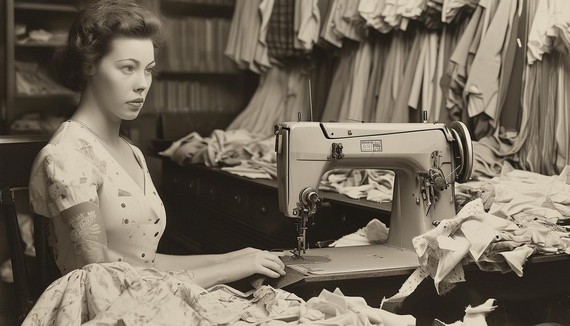
A woman altering a dress at a sewing machine, with fabric scraps and clothing patterns scattered around, illustrating fashion adaptation during the Great Depression
1930s Fashion Key Trends – Popular Patterns and Prints
Floral prints adorned everything from day dresses to evening gowns, typically featuring small, dainty designs set against light backgrounds. As the decade progressed, floral motifs became larger and bolder, integrating more vibrant colors.
Polka dots added a playful yet timeless charm to women’s fashion. The most iconic combination was white polka dots on a navy blue or red background, exuding classic elegance with a touch of fun.
Plaids, including tartan and gingham, were popular especially in winter attire. Tartan skirts, flannel shirts, and woolen coats utilized this pattern extensively. Gingham checks in cheerful colors were favored for summer dresses and casual wear.
Geometric designs, inspired by the Art Deco movement, offered a stark contrast to the softness of florals. These patterns featured bold lines, sharp angles, and abstract shapes, often in a monochromatic or limited color palette.
Hollywood’s influence was unmistakable, with movie stars setting trends that fans eagerly emulated. Actresses like Greta Garbo and Jean Harlow became style icons, often seen in luxurious fabrics adorned with geometric prints or elegant florals.
Novelty prints began to make an appearance, featuring whimsical illustrations that added a unique twist to everyday wear. These prints were typically employed in blouses or casual dresses, injecting personality into the fashion landscape.
The 1930s demonstrated an appreciation for prints that could transform simple fabrics into something visually captivating. These trends embellished garments and told a story of resilience and creativity, resonating with a generation that turned economic restrictions into a canvas for sartorial innovation.
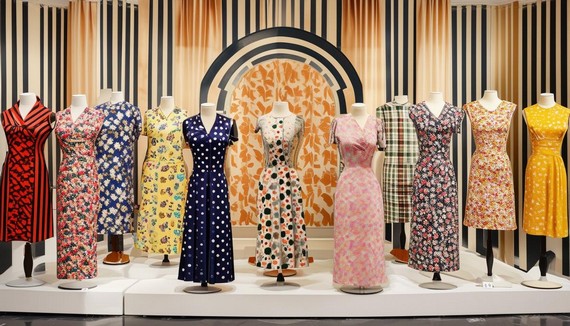
A display of popular 1930s fabric patterns including florals, polka dots, plaids, and geometric designs, arranged on dress forms and in an Art Deco-inspired setting
1930s Fashion Key Trends – Seasonal Fabric Choices
Summer Fabrics
- Cotton: Reigned supreme, with broadcloth, percale, and lawn being popular lightweight varieties
- Rayon: Celebrated for its silk-like appearance without the high cost
- Seersucker: Provided excellent airflow and cooling properties
- Linen: Enhanced the summer fabric repertoire with its breathability
Winter Fabrics
- Wool: Predominant, valued for its insulating properties
- Worsted wool and flannel: Common in suits and dresses
- Wool blends: Incorporating fibers like rayon or cotton, offered a balance of warmth and comfort
- Flannel: Elevated winter wear through its coziness and softness
- Tweeds and corduroys: Winter staples, admired for their durability and fashionable appeal in suits and outerwear
Chambray, a lightweight cousin to denim, was a year-round favorite. Its versatility allowed it to transition seamlessly from summer to winter, used for workwear and casual attire alike.
1930s fashion cleverly balanced practicality with elegance through judicious fabric choices. From the cooling lightness of cotton and rayon in summer to the comforting warmth of wool and flannel in winter, these materials ensured women could dress stylishly and sensibly throughout the year.
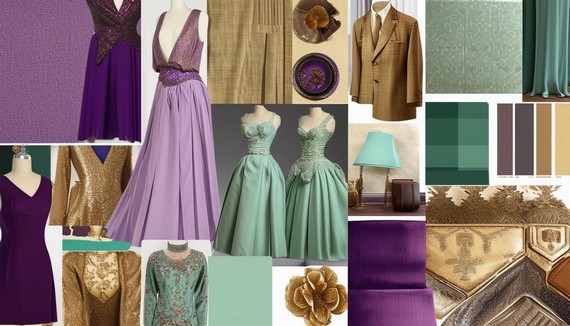
A split image contrasting summer and winter fashion from the 1930s, featuring lightweight cotton dresses and sunhats alongside woolen coats and tweed suits
Evening Wear Fabrics
Evening wear in the 1930s epitomized glamour and sophistication, rooted in luxurious fabrics that defined the era. Silk led the charge, renowned for its sheen and fluid drape. This exquisite material was a favourite for evening gowns and formal wear, effortlessly highlighting the natural form while exuding elegance. Silk dresses often featured intricate details such as beads, sequins, and lace, enhancing their opulent appeal.
Satin, smooth and glossy, was another darling of 1930s evening wear. Its reflective surface made it ideal for bias-cut gowns, which hugged the body’s contours while falling gracefully to the floor. Satin’s rich lustre provided an added dimension under dim lights, creating a shimmering effect. This fabric symbolized Hollywood glamour, with stars like Jean Harlow and Marlene Dietrich dazzling on the silver screen in satin ensembles.
Velvet brought a different luxury, with its plush texture and rich depth of colour. This fabric suited colder evenings, offering warmth without compromising style. Velvet gowns often featured sumptuous hues such as:
- Emerald green
- Royal blue
- Deep burgundy
The fabric’s heavy drape added dramatic flair to evening outfits, making it popular for more formal occasions.
Taffeta, known for its crisp texture and lustrous finish, provided another avenue for stylish evening wear. This fabric offered a structured silhouette, perfect for gowns with voluminous skirts and dramatic folds. Taffeta’s reflective properties contributed to its popularity, as it captured light beautifully, giving evening gowns added brilliance.
Hollywood’s influence in popularizing these luxurious fabrics and styles was significant. Films of the 1930s inspired fashion trends that women worldwide eagerly followed. On-screen, actresses embodied glamour and style, dressed in gowns crafted from silk, satin, velvet, and taffeta. Their wardrobes translated directly into mainstream fashion, where women aspired to replicate the luxe looks of their favourite stars.
Costume designers in Hollywood played a crucial role in shaping evening wear trends. Designers like Adrian, who dressed stars such as Greta Garbo and Joan Crawford, crafted lavish looks that captured public imagination. These designers understood the allure of luxurious fabrics and used them to bring their creations to life, cementing their place in fashion history.
The evening wear fabrics of the 1930s were chosen for their tactile and aesthetic qualities, and their ability to transform the wearer. Silk, satin, velvet, and taffeta each brought unique elements of elegance and sophistication, contributing to the dazzling fashion landscape of the era.
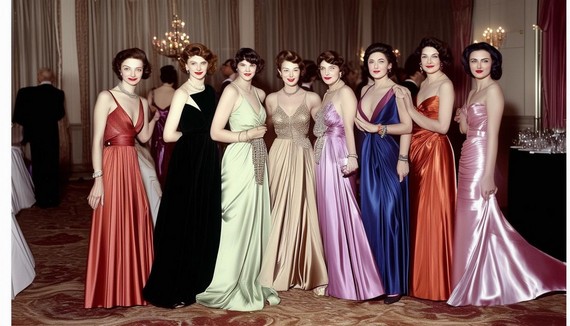
A group of women at a glamorous 1930s evening event, wearing luxurious gowns made from silk, satin, velvet, and taffeta, showcasing the era’s evening wear fabrics
1930s Fashion Key Trends – Accessories and Embellishments
Accessories and embellishments defined the polished, elegant look of 1930s fashion. These elements allowed women to express personal style while following broader trends of the era.
Hats
Hats were essential accessories. Brimmed hats were staples, often worn at jaunty angles for a whimsical touch. Pill box hats gained popularity towards the decade’s end, providing a chic, structured contrast to playful cloche hats from the ’20s. Turbans found favour, especially for formal occasions, adding exotic flair.
Gloves
Gloves were indispensable; no woman would step out without them. For daywear, short gloves made of cloth or leather were common, matching shoes and handbags. Evening gloves, often extending to the elbow or beyond, were must-haves for formal occasions. Made from luxurious materials like silk or satin, they complemented elegant evening gown lines, adding sophistication.
Shoes
Shoes mirrored the practical yet stylish ethos of the time. Popular styles included:
- Rounded toes with wide, thick heels
- Ankle strap shoes with moderate heels
- Flats
- Pumps
- Buckle shoes
Jewellery
Jewellery showcased affordability and glamour. Costume jewellery gained popularity, allowing women to accessorize luxuriously without steep costs. Brooches were favoured, often worn on shoulders or necklines to add sparkle. Pearls, real and faux, graced necks at casual and formal occasions. Art Deco influence was evident in geometric, streamlined designs, reflecting the era’s love for modernity and sophistication.
Fabric Embellishments
Fabric flowers, bows, and lace frequently decorated clothing, enhancing femininity and elegance. These embellishments adorned dresses, blouses, and evening gowns. Fabric flowers added soft, romantic details, often placed on shoulders or waistlines to highlight figures. Bows provided playful or elegant touches, depending on size and placement.
Lace returned triumphantly to fashion in the ’30s after a 1920s hiatus. Used for collars, cuffs, and full overlays on dresses, lace added vintage charm and intricate detail showcasing craftsmanship. Its delicate appearance made it versatile, suitable for day dresses and elaborate evening wear.
Innovative Fastenings
The slide fastener, or zipper, began making its mark in fashion during this decade. Initially used for overshoes, its convenience led to incorporation in women’s dresses. Zippers allowed sleeker silhouettes and eliminated excessive buttons and hooks, embodying the shift towards modern practicality.
Accessories and embellishments in the 1930s were integral to the fashion story. From hat angles to costume jewellery shimmer, each element contributed to a practical and stylish look. Careful selection and pairing of these accessories and embellishments highlighted the era’s dedication to elegance and attention to detail, ensuring women could approach daily life with confidence and grace.
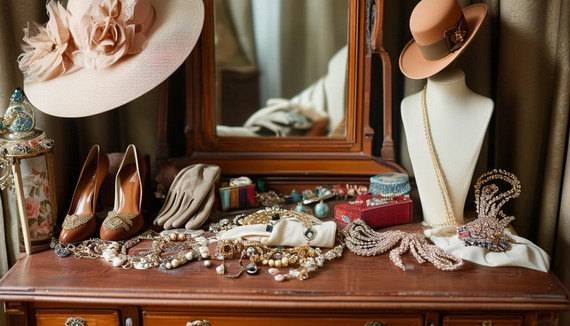
A vintage vanity table displaying popular 1930s accessories including hats, gloves, shoes, jewellery, and fabric embellishments
The fabrics of the 1930s symbolized resilience and creativity. Through careful selection and innovative use, women maintained elegant style despite economic constraints. This blend of practicality and sophistication left a lasting impression on fashion, demonstrating how resourcefulness can lead to enduring elegance.
1930s Fashion Key Trends – 1930s Fashion Colours
Colours played a significant role in shaping the aesthetics and emotions of the 1930s. Marked by economic challenges and societal shifts, this era saw a captivating interplay of hues that reflected the times’ aspirations and realities. From regal purples to calming seafoam, each shade carried its own story, quietly narrating a tale of resilience and hope.
Dominant Colours and Their Significance
Purple shades, from amethyst to orchid, were ubiquitous in the 1930s. Purple’s many shades—from lilac to eggplant—embodied an aspirational touch, making it a favourite in both fashion and graphic design. Amid the Great Depression, purple became emblematic of a longing for stability and grandeur.
Seafoam wasn’t just a colour; it was a lifestyle choice. Curtains, wall paint, and clothing adopted this gentle hue. There’s something soothing about seafoam, much like a whispered reassurance when all else is chaotic. Its various tones permeated everyday life, bringing a slice of serenity to household items and fashion pieces alike.
White was the unsung hero of the 1930s palette. Always the base and never the star, white was the silent collaborator that tied everything together. Dresses, shoes, accessories—white was present. The practicality of it was fitting, given the economic backdrop. White symbolised hope and cleanliness, a blank canvas in a time of hardship.
Colour combinations like pink and seafoam became signature looks. This duo, muted and dusty, was like finding an old love letter—soft, faded, yet undeniably captivating. Unlike the bold aesthetics of the 1950s, these colours spoke in hushed tones, mirroring the subdued atmosphere of the era.
Gold and bronze also staked their claim, draping everything from architecture to evening wear in their warm, luxurious glow. These colours, especially when complemented by pearl, created a look that was both opulent and calming. While silver reigned supreme in the 1920s, the 1930s saw gold and bronze take over, offering a touch of glamour against the otherwise sombre backdrop.
Blue, particularly powdered blue, exuded an understated elegance. Paired frequently with beige—even in hues like flaxen, maize, or ecru—this combination reflected a gentle sophistication that was both timeless and reflective of the societal temperament.
Orange, surprisingly bold for the times, found its footing towards the end of the decade. The introduction of Technicolor brought a wave of vibrant shades, with emerald green emerging as a new favourite in 1939. This marked a shift towards more vibrant, saturated tones.
Floral prints, small and painterly, whispered a little optimism into the fabric of everyday life. As the decade wore on, these florals grew bolder, their abstracts more artsy. Polka dots were often present in accessories and trims, while paisley found a home in this decade, proof that even during tough times, there was room for a bit of whimsy.
The colour choices of the 1930s weren’t just about aesthetics; they reflected a desire for calm and stability in a challenging world. These muted, dusty hues quietly told a story of resilience, hope, and a subtle longing for joy amidst the chaos.
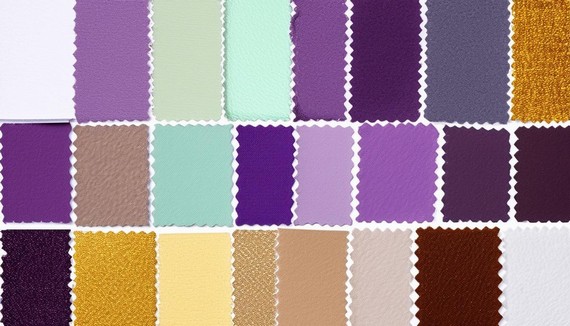
A collection of colour swatches representing the dominant hues of the 1930s, including purple, seafoam, white, gold, and bronze
1930s Fashion Key Trends – Seasonal Colour Trends
Spring and summer in the 1930s embraced lighter pastels and more saturated hues. Peach, rose pink, lilac, sunny yellow, sky blue, and sea green were the gentle brushstrokes on the canvas of everyday life. These colours were soothing balms, counteracting the harshness of the Great Depression. Women gravitated towards these shades for their ethereal beauty and the comforting sense they imparted.
As autumn and winter arrived, jewel tones and earthier hues made their grand entrance. Chocolate brown, grey, tan, rust, burgundy, navy blue, and black brought a sense of stability and warmth to the cold months.
The 1930s had a beautiful way of blending contrasting shades. The playful symbiosis of blue and pink or the unexpected harmony between yellow and green created softer, more considered pairings that resonated with the unique ambience of the decade.
White played the role of the all-encompassing anchor—complementing every seasonal colour. From gingham checks to stripes and florals, white balanced the visual harmony. It found its place on collars, cuffs, gloves, and hats, quietly yet significantly contributing to the overall aesthetic.
Spring and summer fashion saw women turn to small, painterly florals that adorned dresses and accessories. By autumn and winter, these prints darkened slightly, as if absorbing the richness of the season—though never losing their inherent charm.
The seasonal colour trends of the 1930s didn’t just influence fashion; they encapsulated a collective yearning for normalcy, joy, and beauty. Amidst global upheavals, these colours provided solace and a whisper of hope—quiet yet impactful.
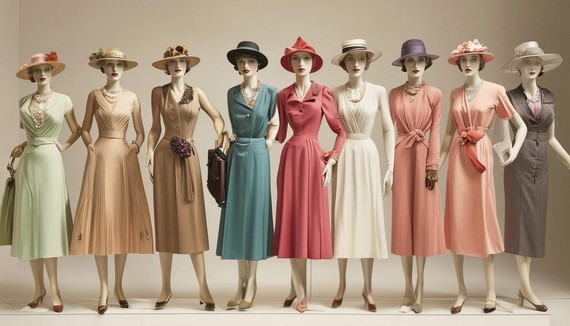
A display of 1930s seasonal fashion, showing light pastels for spring/summer and jewel tones for autumn/winter
1930s Fashion Key Trends – Popular Colour Combinations
Among the most celebrated colour combinations of the 1930s was the pairing of purple and seafoam. This duo, in its muted, dusty iterations, could be found gracing everything from elegant evening gowns to more casual day dresses. Women draped in these colours seemed to personify both grace and quiet defiance, reflecting a collective wish for peace amidst the turmoil of the times.
Another cherished combination was pink and seafoam. This pairing exuded softness yet was imbued with a sense of understated strength. Pink in the form of “Schiaparelli pink” or hot pink often dominated high fashion, but when toned down with seafoam, it found its way into everyday wear. Tea dresses with pink floral patterns set against seafoam backgrounds, or household items like tablecloths and curtains, brought a light-hearted elegance to domestic settings.
The blend of gold and bronze brought a touch of opulence into an otherwise sombre era. This pair was particularly favoured in accessories and evening attire. Gold and bronze lent a warm glow to jewellery, handbags, and shoes. In architectural design, this combination dominated, accentuating the geometric lines and curves characteristic of Art Moderne.
In household décor, these colour combinations were equally impactful. Seafoam painted walls contrasted with purple curtains made for rooms that felt peaceful and inviting. Pink and seafoam linens or upholstery brought a touch of softness to living spaces. Gold and bronze accents in furniture and light fixtures added a dash of sophistication.
These combinations effortlessly traversed categories. In fashion, they adorned everything from accessories to high-end couture, while in home décor, they imbued a sense of delicate luxury. The versatile nature of gold and bronze meant these colours not only adorned clothing and jewellery but also touched everything from door handles to cabinet fixtures.
These popular colour combinations of the 1930s weren’t merely about aesthetics; they were expressions of the era’s emotional landscape. They captured the collective yearning for both stability and refinement, bridging the gap between the harsh realities of the time and an enduring aspiration for beauty and elegance.
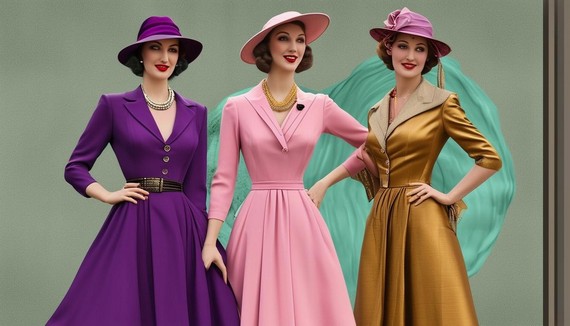
Three 1930s outfits showcasing popular colour combinations: purple and seafoam, pink and seafoam, and gold and bronze
Influence of Technological and Cultural Shifts
As the 1930s drew to a close, technological progress and cultural changes significantly influenced colour schemes. Technicolor brought vivid hues to cinema screens, impacting fashion and household items. People were captivated by the rich, saturated colours that contrasted with the muted tones prevalent earlier in the decade.
Emerald green surged in popularity within fashion, inspired by films like “The Wizard of Oz” in 1939. This bold shade diverged from the subdued greens seen previously. Similarly, intense blues and bright reds encouraged designers to experiment with more vivid colours.
Technicolor’s influence extended into home décor, creating a desire for vibrant hues in everyday life. Consider these examples:
- Emerald green cushions
- Sapphire blue drapes
- Ruby red kitchen accessories
The Bauhaus movement also left a lasting impression on 1930s colour choices. Emphasizing functionality and simplicity, Bauhaus embraced primary colours—blue, red, and yellow—alongside black and white. These hues became staples in modernist designs, influencing fashion and architecture.
In clothing, Bauhaus prompted a shift to cleaner lines and straightforward colour schemes. Primary colours paired with black or white created striking, minimalist looks that contrasted with the softer styles of the early decade.
In architecture and home décor, Bauhaus inspired the use of primary colours with sleek, geometric designs. Interiors began featuring colour-blocked walls in red, blue, or yellow, complemented by black or white accents.
The interplay between Technicolor and Bauhaus influences created a unique palette defining late 1930s fashion and design. Vivid Technicolor-inspired hues merged with Bauhaus-inspired primary shades, allowing for creative freedom while maintaining practicality.
The 1930s cultural landscape was one of adaptation and innovation. Colour choices reflected this, showing a fascinating duality—opulent yet restrained, modern yet nostalgic. The decade’s colour palettes became a testament to the times’ resilience and ingenuity, capturing the spirit of an era defined by contrasts and transformations.
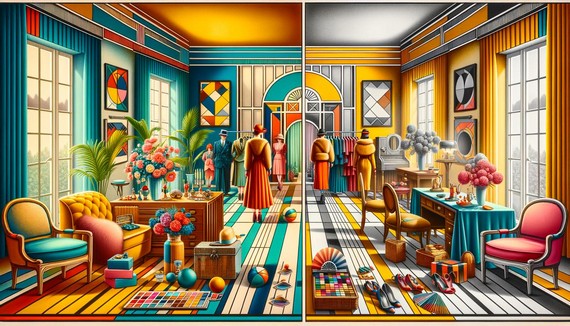
A split image showing the influence of Technicolor films and Bauhaus design on 1930s fashion and decor
1930s Fashion Key Trends – Patterns and Prints
Florals remained popular in the 1930s, adorning various garments and accessories. Initially small and painterly, they evolved throughout the decade—growing slightly larger yet retaining their delicate charm. By the mid to late 1930s, these floral prints embraced a more tropical flair, introducing bolder abstractions while still incorporating the muted tones of the period.
Polka dots added a playful spirit to the restrained palette of the decade. Often white on blue, pink, or green backgrounds, these dots presented a minimalistic pattern that caught the eye. They subtly amplified the era’s understated elegance with their playful bounce.
Plaid found new forms in the 1930s:
- Tartan plaids
- Gingham checks
- Windowpane patterns
These plaids emerged with a simplified aesthetic, often featuring two or three colours, with white frequently employed to keep designs clean and straightforward. They were widely used for house dresses and casual frocks.
Paisley found its footing in the 1930s as a symbol of grandeur and artistry. These prints adorned luxurious dress suits and elegant frocks, their swirling forms acting as an artistic statement. Paisley prints paired unexpectedly well with the era’s muted tones, transforming ordinary outfits into wearable art.
These patterns and prints worked in concert with the colour palettes of the time to craft a cohesive visual story:
| Pattern | Typical Colors |
|---|---|
| Florals | Mauve, lavender, seafoam |
| Polka dots | Lilacs, pinks, pale blues |
| Plaids | Pastel symphony |
| Paisleys | Luxurious gold and bronze tones |
The patterns also transitioned beautifully to home décor. Floral prints adorned curtains, bedspreads, and upholstery. Polka dots found their way onto kitchen textiles and children’s room decor. Plaids and paisleys graced everything from wallpaper to area rugs.
Throughout the 1930s, patterns and prints were crucial in softening the harsh realities of the time. They offered a form of quiet rebellion against the backdrop of the Great Depression, a means to inject beauty and joy into everyday life. Whether through florals, polka dots, plaids or paisley, these patterns captured the resilience and elegance that defined the decade.
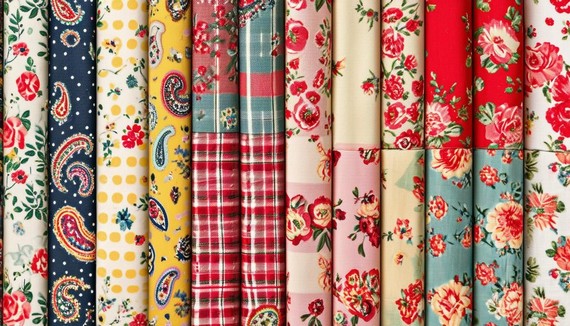
A collection of fabric samples showcasing popular 1930s patterns including florals, polka dots, plaids, and paisleys
The colours of the 1930s exemplified the human spirit’s ability to find beauty and solace even in challenging times. These hues captured a collective yearning for stability and elegance. As we reflect on this decade, it’s clear that the colours weren’t simply about trends; they were about finding light amidst the darkness.


